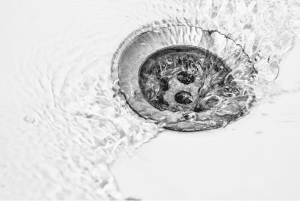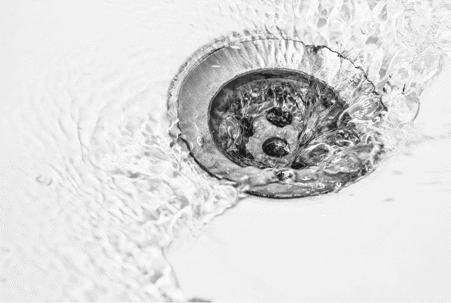Today, we’re diving into the exciting world of drain-cleaning bladders – the secret weapon for conquering clogged pipes and restoring the flow in your plumbing kingdom. While big plumbing jobs are better suited to the professionals, this is something that you can do yourself! You can quickly unclog drains with this handy little plumbing tool.

What is a Drain Cleaning Bladder?
Alright, first things first. What exactly is a drain-cleaning bladder, you ask? Well, it’s a handy, flexible tool that inflates inside your clogged pipe, exerting pressure on the blockage, and uses the force of water to purge the offending clog. Now that you know what it is, let’s find out how to use it.
Step 1: Gather Your Tools
Before you go charging into battle, you’ll need a few trusty items:
- Drain Cleaning Bladder: This is your main weapon of choice. It comes in various sizes, so pick one that matches the diameter of your pipe.
- Safety Gear: Just like any superhero, you need protection! Grab some safety goggles to shield your eyes from splashes and debris.
- Plumbing Snake: In case the blockage is a tough nut to crack, a plumbing snake can help break it up.
- Garden Hose: You’ll need this to connect to the drain cleaning bladder.
Step 2: Locate the Offending Drain
Identify the clogged drain you want to rescue. Whether it’s the kitchen sink, bathroom shower, or the dreaded basement drain, pinpoint your target.
Step 3: Prepare for Action
Here’s where the fun begins:
- Safety First: Don your safety goggles to protect those peepers from unexpected splashes.
- Deflate the Bladder: If your drain cleaning bladder is pre-inflated, gently deflate it by pressing the release valve.
- Attach the Hose: Connect one end of your garden hose to the bladder and the other end to your outdoor faucet. Make sure it’s secure.
Step 4: Insert and Inflate
- Insert the Bladder: Carefully insert the deflated bladder into the drain until it’s as far as it can go. You’re in the lair of the clog now!
- Inflate It: Turn on the outdoor faucet slowly to allow water to flow into the bladder. As it fills, it’ll expand and press against the clog with brute force.
Step 5: Conquer the Clog
Stand back and let the drain-cleaning bladder do its thing. You’ll hear it working its magic as it forces its way through the blockage.
Step 6: Release and Repeat (If Necessary)
Once the water flows freely again, turn off the outdoor faucet and let the bladder deflate. Carefully remove it from the drain. If the clog remains stubborn, don’t give up – repeat the process until victory is yours!
Step 7: Clean Up and Celebrate
Dispose of any debris, clean up your tools, and bask in the glory of your plumbing triumph! You’ve just saved the day and your hard-earned cash.
Using a drain-cleaning bladder is like having a trusty sidekick in your plumbing adventures. With a little know-how and the right tools, you can tackle clogs like a pro.
Know the Common Causes of Clogs
When it comes to clogs, there are many things that can get stuck in your pipes and result in a blockage. These are some common causes of clogs in most modern plumbing systems.
Grease and Cooking Oils
Grease and cooking oils are sneaky foes. When poured down the kitchen sink, they may appear harmless, but as they cool, they congeal and stick to the inside of your pipes, creating a stubborn clog. To prevent this, collect cooking grease in a container and dispose of it in the trash, not down the drain.
Hair
Hair is a notorious troublemaker, especially in bathroom drains. Strands of hair can tangle with soap scum and other debris, forming a barrier that slows water flow or stops it altogether. Using drain screens or hair catchers in your shower or tub can help trap hair before it wreaks havoc on your pipes.
Soap Scum
Soap scum may seem harmless, but over time, it can accumulate and harden inside pipes. This can lead to reduced water flow and clogs. Using soap-free or low-sudsing soap options can minimize soap scum buildup.
Foreign Objects
Sometimes, foreign objects accidentally find their way into drains. These can include dental floss, cotton swabs, small toys, or even jewelry. To prevent this, keep drains covered with screens or guards and dispose of foreign objects properly.
Food Particles
In the kitchen, food particles are a common culprit, especially in garbage disposals. Items like coffee grounds, eggshells, and starchy or fibrous foods can cause blockages. Be cautious about what you put down the disposal and use cold water to help flush debris.
Toiletries
Items like sanitary products, wet wipes, and cotton balls should never be flushed down the toilet. These can easily become lodged in the pipes and cause blockages. Use a trash bin for disposal instead.
Mineral Buildup
Hard water can lead to mineral buildup in pipes over time. This can restrict water flow and contribute to clogs. Regularly cleaning your fixtures and using water softeners can help prevent mineral buildup.
Tree Roots
In outdoor sewer lines, tree roots can infiltrate and cause serious clogs. Regular maintenance and inspections by a professional plumber can help identify root intrusion early.
Aging Pipes
Older pipes may develop corrosion or scale buildup inside, increasing the likelihood of clogs. Regular inspections and pipe maintenance can help address issues before they become major blockages.
By understanding these common culprits behind drain clogs, you can take proactive steps to prevent future blockages. Remember, a little prevention goes a long way in keeping your plumbing flowing smoothly.
Preventing Future Clogs
Preventing future clogs is the name of the game. Once you get those pipes clear, you want them to stay that way. Here are some handy tips to keep your pipes flowing smoothly and avoid those pesky blockages:
Enzyme-Based Drain Cleaners
Consider using enzyme-based drain cleaners regularly. These cleaners contain natural enzymes that break down organic matter like soap scum, hair, and food particles, helping to maintain clean and clog-free pipes. Follow the product instructions for optimal results.
Use Mesh Strainers or Hair Catchers
Install mesh strainers or hair catchers in your shower and bathtub drains. These inexpensive devices trap hair and debris before they can enter your plumbing system, preventing clogs from forming in the first place.
Dispose of Cooking Grease Properly
Instead of pouring cooking grease down the sink, collect it in a container and dispose of it in the trash. A perfect vessel for cooling grease is an empty vegetable can. Once it cools there is no worry about spills. This simple habit can prevent grease buildup in your pipes, which can lead to stubborn clogs.
Regularly Flush Drains
Give your drains a regular flush to keep them clear. Pour hot water down the kitchen sink after each use to help flush away any grease or food particles. For bathroom sinks and tubs, a monthly flush with hot water can help prevent soap scum buildup.
Be Mindful of What You Flush
Only flush toilet paper down the toilet. Avoid flushing items like wet wipes, paper towels, sanitary products, and cotton balls, as these can easily clog your toilet and sewer lines.
Dispose of Food Scraps Responsibly
Scrape food scraps from dishes into the trash or compost bin before washing them in the sink. Avoid letting food particles go down the drain to prevent kitchen sink clogs.
Annual Plumbing Inspections
Schedule annual plumbing inspectionswith a professional plumber. They can identify potential issues, like mineral buildup or aging pipes, and address them before they become major clogs.
Armed with these tips and tricks, you’re well on your way to keeping your plumbing running smoothly. However, should you ever find yourself face-to-face with a clog that refuses to budge, remember that you don’t have to go it alone.
R.S. Andrewsis just a call away, ready to dispatch our team of expert plumbers to tackle even the toughest clogs. Your comfort and peace of mind are our top priorities, so don’t hesitate to reach out if you need a helping hand. We’re here to ensure your plumbing remains a well-oiled machine.

